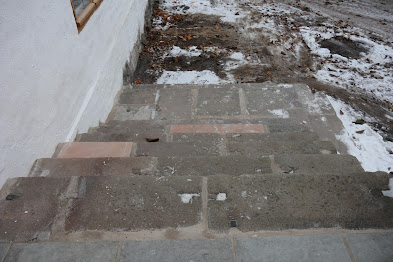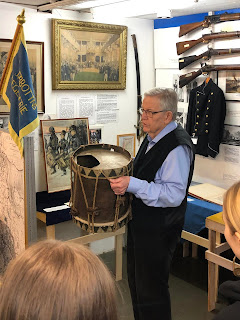Kerrotaan, että
aloitteen museon perustamiseksi teki toimittaja Waldemar Sandman. Vaasaan ja
Pohjanmaalle piti saada oma museo. Tammikuun 26 päivä 1895 kokoontui
viitisentoista kulttuurista ja historiasta kiinnostunutta henkilöä
ruotsalaiselle lyseolle, jossa valittiin tilapäinen hallitus professori Johan Oskar
Immanuel (J.O.I.) Ranckenin johdolla
laatimaan säännöt suunnitellulle museoyhdistykselle, joka perustettiin
huhtikuun 27. päivänä 1895.
Yhdistys
järjestäytyi 15. lokakuuta ja valitsi hallituksen jäseniksi seuraavat henkilöt:
maisteri Otto Alcenius, filosofian tohtori Henrik Emanuel Aspelin, hovioikeuden
notaari Lorenzo Kihlman, hovioikeuden viskaali Oskar Rewell, lääninarkkitehti
Viktor Reinius, rehtori Vilhelm Teodor Rosenqvist, pankin komissaari N. Sundman,
toimittaja Waldemar Sandman ja lehtori Knut Sääf. Rancken oli menehtynyt
keväällä ja niinpä yhdistyksen ensimmäiseksi puheenjohtajaksi valittiin Rewell
(Viljo Rewellin isä) ja sihteeriksi Sääf. Suurin osa enemmän tai vähemmän sukua
toisilleen ja Oskar Ranckenin oppilaita.
Ensimmäinen
näyttely toteutettiin jo 1896 pormestari Victor Cajanuksen talossa ja pian sen
jälkeen kauppias Tuomas Laurellin talossa lähellä rautatieasemaa. Karl Hedman
tuli mukaan yhdistyksen toimintaan 1899 ja hänet valittiin varainhoitajaksi
1903.
Ensimmäisenä
vuonna kokoelmissa oli jo 200 esinettä seuraavana jo 1000 ja vuonna 1914 jo yli
3000. Alusta asti aina vuoteen 1919 museon intendenttinä toimi maisteri Knut
Sääf, joka huolellisesti luetteloi hankitut esineet, joita tuli usein
asiamiesten kautta pohjoisessa aina Oulun korkeudelta, idässä Jyväskylän
seudulta ja etelässä Satakunnan pohjois-osista tietenkään unohtamatta muita
silloisen Vaasan läänin alueita. Hankinnoista vastasi jo varhain Karl Hedman,
jolla oli jo oma karttuva kulttuurihistoriallinen kokoelma ja laaja
taidekokoelma. Hedman toimi vuodesta 1923 lähtien intendenttinä ja lopulta myös
yhdistyksen puheenjohtajana.
Museotilat Laurellin talossa kävivät pian ahtaaksi ja 1920-luvun alussa alettiin suunnitella uutta museorakennusta. Siihen löytyi rahoitus Suomen valtiolta, Vaasan kaupungilta ja 11 ympäristön kunnalta sekä kaupungeilta. Suurimmat yksityiset lahjoittajat olivat varakonsuli Eugen Wolff ja apteekkari Vasili Smirnoff. Museon suunnittelijaksi valittiin arkkitehti Eino Forsman ja työt aloitettiin Marian puistossa vuonna 1928. Kuvanveistäjä Emil Wikströmiltä tilattiin pronssiovet, joiden korkokuvissa kuvataan Pohjanmaan merkittävimpiä historiallisia vaiheita. Mallia oviin hän otti Firenzestä. Karl ja Elin Hedman saivat käyttöönsä uuden museorakennuksen ylimmän kerroksen kokoelmien sijoituspaikaksi ja kodiksi. Ison ja upean museotalon ja muistohallin vihki juhlallisesti käyttöön Suomen presidentti Lauri Kristian Relander 28. kesäkuuta päivänä 1930.
Museon
vihkipäivä lauantai 28.6.1930
Ensimmäisenä
vihittiin klo 13-14 Muistohalli.
Ohjelmassa oli Alkusoitto, Karl Hedmanin tervehdyspuhe, jonka jälkeen
”Tasavallan Herra Presidentti” Relander vihki muistohallin. Sitä seurasi
Rukous, jonka piti teologian tohtori Isak August Björklund. Lopuksi veisattiin
Jumala ompi linnamme.
Seuraavaksi
oli luultavasti Hedmanin opastus museossa klo 14-15 ja klo 15-17 oli museon
vihkiäisjuhla puistossa.
Se alkoi
Vaasan marssilla (kuoro ja orkesteri). Tervehdyssanat lausui maaherra B Sarlin.
Sen jälkeen ”Tasavallan Herra Presidentti” (Relander) piti puheen isänmaalle ja
vihki museon. Sitten mieskuoro Wasa sångargille esitti kappaleet ”Österbotten”
ja Wasa namnet”, joiden jälkeen oli juhlapuheen vuoro. Sen piti
valtionarkeologi Juhani Rinne. Puheen jälkeen esiintyi sekakuoro Sirpaleet ja
orkesteri esittäen kappaleen ”Vapautettu kuningatar”. Tämän jälkeen oli
vuorossa ”Kiitospuhe museon suosijoille”, jonka esitti professori Karl Hedman.
Lopuksi laulettiin Maamme.
Professori Karl
Hedman oli saanut järjestettyä omat kokoelmansa toiseen kerrokseen ja
Kansallismuseon amanuenssi Nils Cleve sisusti varsinaisen museon. Karl Hedman
kuoli jo 29.4.1931 vain 66 vuoden ikäisenä. Vain pari kuukautta aiemmin hän ja
hänen puolisonsa Elin (os. Hassellblatt) olivat lahjoittaneet arvokkaat
antikviteetti- ja taidekokoelmansa museon haltuun sekä puolet huomattavasta
omaisuudestaan, jonka korot määrättiin käytettäväksi museokokoelmien
kartuttamiseen ja joista huolehtisi sitä varten vuonna 1931 heidän perustamansa
Hedmanin säätiö.
Kun Vaasan
palosta oli kulunut 100 vuotta vuonna 1952, tehtiin Wasastjernan talosta
Vanhassa Vaasassa museo. Pohjanmaan museo kunnallistettiin 1990, jolloin se oli
jo toiminut 10 vuotta maakuntamuseona ja seitsemän vuotta aluetaidemuseona.
2010-luvulla Tikanojan taidekoti ja Kuntsin modernin taiteen museo liitettiin
maakuntamuseoon, josta 2020-luvun alussa tuli alueellinen vastuumuseo.
Det berättas att initiativet till att grunda museet togs
av journalisten Waldemar Sandman. Vasa och Österbotten behövde få ett eget
museum. Den 26 januari 1895 samlades ett femtontal personer med intresse för
kultur och historia vid det svenska lyceet, där en tillfällig styrelse under
ledning av professor Johan Oskar Immanuel Rancken valdes för att
utarbeta stadgar för den planerade museiföreningen, som grundades den 27 april
1895.
Föreningen konstituerade sig den 15 oktober och valde
följande personer till styrelseledamöter: magister Otto Alcenius, filosofie
doktor Henrik Emanuel Aspelin, hovrättsnotarie Lorenzo Kihlman, hovrättsfiskal
Oskar Rewell, länsarkitekt Viktor Reinius, rektor Vilhelm Teodor Rosenqvist,
bankkommissarie N. Sundman, journalist Waldemar Sandman och lektor Knut Sääf.
Rancken hade avlidit på våren och därför valdes Rewell till föreningens första
ordförande och Sääf till sekreterare. De flesta var mer eller mindre släkt med
varandra och elever till Oskar Rancken.
Den första utställningen hölls redan 1896 i borgmästare
Cajanus hus och strax därefter i Laurells hus nära järnvägsstationen. Karl
Hedman kom med i föreningens verksamhet 1899 och valdes till kassör 1903.
Redan under det första året omfattade samlingarna 200
föremål och år 1914 över 3000. Från början och ända fram till 1919 verkade
magister Knut Sääf som museets intendent. Han förde noggrant katalog över de
förvärvade föremålen, som ofta kom via ombud norrifrån ända från
Uleåborgstrakten, i öster från Jyväskyläområdet och i söder från norra
Satakunta – naturligtvis utan att glömma övriga delar av dåvarande Vasa län.
För inköpen ansvarade tidigt Karl Hedman, som redan hade en växande
kulturhistorisk samling och en omfattande konstsamling. Hedman verkade från
1923 som intendent och blev slutligen även föreningens ordförande.
Museilokalerna i Laurells hus blev snart trånga och i
början av 1920-talet började man planera en ny museibyggnad. Finansiering
erhölls från finska staten, Vasa stad och 11 kringliggande kommuner samt
städer. De största privata donatorerna var vicekonsul Eugen Wolff och apotekare
Vasili Smirnoff. Till arkitekt utsågs Eino Forsman och arbetet inleddes i Maria
parken år 1928. Det stora och ståtliga museihuset och minneshallen invigdes
högtidligt av Finlands president Lauri Kristian Relander den 28 juni 1930.
Museets invigningsdag lördagen den 28.6.1930
Först invigdes Minneshallen kl. 13–14. Programmet bestod av Ouvertyr,
hälsningstal av Karl Hedman, varefter ”Republikens Herr President” Relander
invigde Minneshallen. Därefter följde bön, hållen av teologie doktor Isak
August Björklund. Avslutningsvis sjöngs ”Vår Gud är oss en väldig borg”.
Därefter hölls sannolikt Hedmans guidning i museet kl.
14–15 och mellan kl. 15–17 ägde museets invigningsfest rum i parken.
Den inleddes med Vasa-marschen (kör och orkester). Landshövding B. Sarlin höll
hälsningstalet. Sedan höll ”Republikens Herr President” (Relander) ett
fosterlandstal och invigde museet. Därefter framförde manskören Wasa
sångargille sångerna ”Österbotten” och ”Wasa namnet”, varefter det var dags för
festtalet. Detta hölls av statsarkeologen Juhani Rinne. Efter talet uppträdde
blandkören Sirpaleet och orkestern med stycket ”Den befriade drottningen”.
Därefter höll professor Karl Hedman ”Tacktal till museets vänner”.
Avslutningsvis sjöngs ”Vårt land”.
Professor Karl Hedman hade fått ordna sina egna samlingar
i andra våningen och Nationalmuseets amanuens Nils Cleve inredde själva museet.
Karl Hedman avled redan den 29.4.1931 endast 66 år gammal. Bara ett par månader
tidigare hade han och hans hustru Elin (född Hassellblatt) donerat sina
värdefulla antikvitets- och konstsamlingar till museet samt hälften av sin
betydande förmögenhet, vars ränta skulle användas för att utöka museets
samlingar och som skulle förvaltas av Hedmans stiftelse, grundad 1931.
När det hade gått 100 år sedan Vasa brand år 1952,
inrättades Wasastjernas hus i Gamla Vasa som museum. Österbottens museum
kommunaliserades 1990, då det redan hade verkat i 10 år som landskapsmuseum och
i sju år som regionalt konstmuseum. Under 2010-talet anslöts Tikanojas konsthem
och Kuntsis museum för modern konst till landskapsmuseet, som i början av
2020-talet blev regionalt ansvarsmuseum.
Kirjoittaja / Författare: Kaj Höglund, maakuntamuseotutkija / regionmuseiforskare, Vaasan museot / Vasas museer
































